Yusen Zhang
Break Stylistic Sophon: Are We Really Meant to Confine the Imagination in Style Transfer?
Jun 18, 2025Abstract:In this pioneering study, we introduce StyleWallfacer, a groundbreaking unified training and inference framework, which not only addresses various issues encountered in the style transfer process of traditional methods but also unifies the framework for different tasks. This framework is designed to revolutionize the field by enabling artist level style transfer and text driven stylization. First, we propose a semantic-based style injection method that uses BLIP to generate text descriptions strictly aligned with the semantics of the style image in CLIP space. By leveraging a large language model to remove style-related descriptions from these descriptions, we create a semantic gap. This gap is then used to fine-tune the model, enabling efficient and drift-free injection of style knowledge. Second, we propose a data augmentation strategy based on human feedback, incorporating high-quality samples generated early in the fine-tuning process into the training set to facilitate progressive learning and significantly reduce its overfitting. Finally, we design a training-free triple diffusion process using the fine-tuned model, which manipulates the features of self-attention layers in a manner similar to the cross-attention mechanism. Specifically, in the generation process, the key and value of the content-related process are replaced with those of the style-related process to inject style while maintaining text control over the model. We also introduce query preservation to mitigate disruptions to the original content. Under such a design, we have achieved high-quality image-driven style transfer and text-driven stylization, delivering artist-level style transfer results while preserving the original image content. Moreover, we achieve image color editing during the style transfer process for the first time.
Enhance Multimodal Consistency and Coherence for Text-Image Plan Generation
Jun 13, 2025Abstract:People get informed of a daily task plan through diverse media involving both texts and images. However, most prior research only focuses on LLM's capability of textual plan generation. The potential of large-scale models in providing text-image plans remains understudied. Generating high-quality text-image plans faces two main challenges: ensuring consistent alignment between two modalities and keeping coherence among visual steps. To address these challenges, we propose a novel framework that generates and refines text-image plans step-by-step. At each iteration, our framework (1) drafts the next textual step based on the prediction history; (2) edits the last visual step to obtain the next one; (3) extracts PDDL-like visual information; and (4) refines the draft with the extracted visual information. The textual and visual step produced in stage (4) and (2) will then serve as inputs for the next iteration. Our approach offers a plug-and-play improvement to various backbone models, such as Mistral-7B, Gemini-1.5, and GPT-4o. To evaluate the effectiveness of our approach, we collect a new benchmark consisting of 1,100 tasks and their text-image pair solutions covering 11 daily topics. We also design and validate a new set of metrics to evaluate the multimodal consistency and coherence in text-image plans. Extensive experiment results show the effectiveness of our approach on a range of backbone models against competitive baselines. Our code and data are available at https://github.com/psunlpgroup/MPlanner.
Training Step-Level Reasoning Verifiers with Formal Verification Tools
May 21, 2025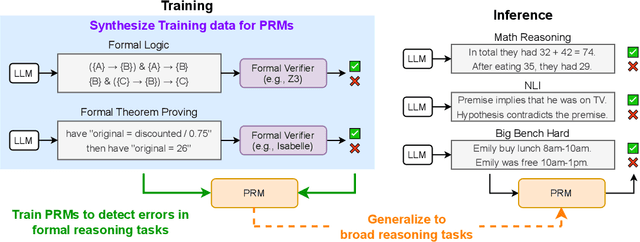



Abstract:Process Reward Models (PRMs), which provide step-by-step feedback on the reasoning generated by Large Language Models (LLMs), are receiving increasing attention. However, two key research gaps remain: collecting accurate step-level error labels for training typically requires costly human annotation, and existing PRMs are limited to math reasoning problems. In response to these gaps, this paper aims to address the challenges of automatic dataset creation and the generalization of PRMs to diverse reasoning tasks. To achieve this goal, we propose FoVer, an approach for training PRMs on step-level error labels automatically annotated by formal verification tools, such as Z3 for formal logic and Isabelle for theorem proof, which provide automatic and accurate verification for symbolic tasks. Using this approach, we synthesize a training dataset with error labels on LLM responses for formal logic and theorem proof tasks without human annotation. Although this data synthesis is feasible only for tasks compatible with formal verification, we observe that LLM-based PRMs trained on our dataset exhibit cross-task generalization, improving verification across diverse reasoning tasks. Specifically, PRMs trained with FoVer significantly outperform baseline PRMs based on the original LLMs and achieve competitive or superior results compared to state-of-the-art PRMs trained on labels annotated by humans or stronger models, as measured by step-level verification on ProcessBench and Best-of-K performance across 12 reasoning benchmarks, including MATH, AIME, ANLI, MMLU, and BBH. The datasets, models, and code are provided at https://github.com/psunlpgroup/FoVer.
NeuroGen: Neural Network Parameter Generation via Large Language Models
May 18, 2025Abstract:Acquiring the parameters of neural networks (NNs) has been one of the most important problems in machine learning since the inception of NNs. Traditional approaches, such as backpropagation and forward-only optimization, acquire parameters via iterative data fitting to gradually optimize them. This paper aims to explore the feasibility of a new direction: acquiring NN parameters via large language model generation. We propose NeuroGen, a generalized and easy-to-implement two-stage approach for NN parameter generation conditioned on descriptions of the data, task, and network architecture. Stage one is Parameter Reference Knowledge Injection, where LLMs are pretrained on NN checkpoints to build foundational understanding of parameter space, whereas stage two is Context-Enhanced Instruction Tuning, enabling LLMs to adapt to specific tasks through enriched, task-aware prompts. Experimental results demonstrate that NeuroGen effectively generates usable NN parameters. Our findings highlight the feasibility of LLM-based NN parameter generation and suggest a promising new paradigm where LLMs and lightweight NNs can coexist synergistically
HRScene: How Far Are VLMs from Effective High-Resolution Image Understanding?
Apr 29, 2025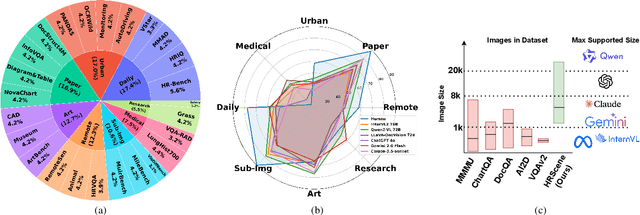
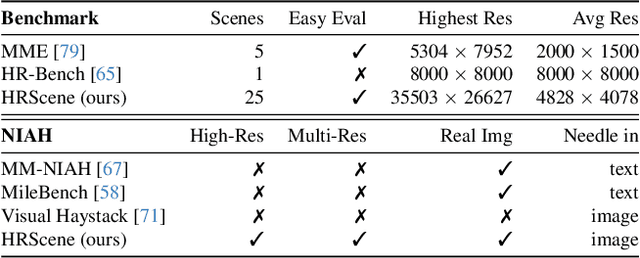
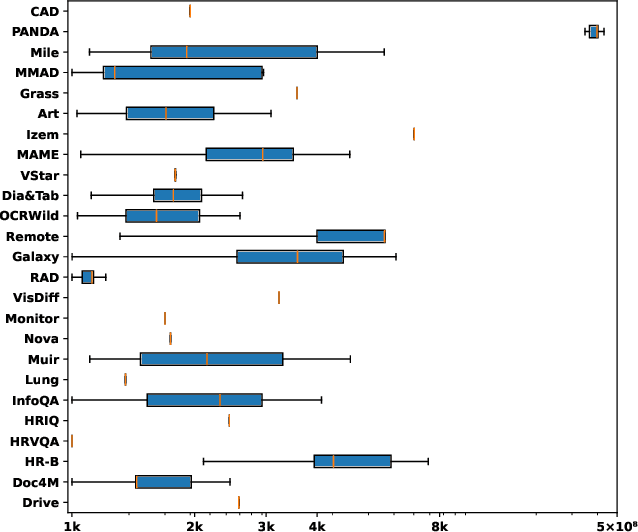

Abstract:High-resolution image (HRI) understanding aims to process images with a large number of pixels, such as pathological images and agricultural aerial images, both of which can exceed 1 million pixels. Vision Large Language Models (VLMs) can allegedly handle HRIs, however, there is a lack of a comprehensive benchmark for VLMs to evaluate HRI understanding. To address this gap, we introduce HRScene, a novel unified benchmark for HRI understanding with rich scenes. HRScene incorporates 25 real-world datasets and 2 synthetic diagnostic datasets with resolutions ranging from 1,024 $\times$ 1,024 to 35,503 $\times$ 26,627. HRScene is collected and re-annotated by 10 graduate-level annotators, covering 25 scenarios, ranging from microscopic to radiology images, street views, long-range pictures, and telescope images. It includes HRIs of real-world objects, scanned documents, and composite multi-image. The two diagnostic evaluation datasets are synthesized by combining the target image with the gold answer and distracting images in different orders, assessing how well models utilize regions in HRI. We conduct extensive experiments involving 28 VLMs, including Gemini 2.0 Flash and GPT-4o. Experiments on HRScene show that current VLMs achieve an average accuracy of around 50% on real-world tasks, revealing significant gaps in HRI understanding. Results on synthetic datasets reveal that VLMs struggle to effectively utilize HRI regions, showing significant Regional Divergence and lost-in-middle, shedding light on future research.
GREATERPROMPT: A Unified, Customizable, and High-Performing Open-Source Toolkit for Prompt Optimization
Apr 04, 2025

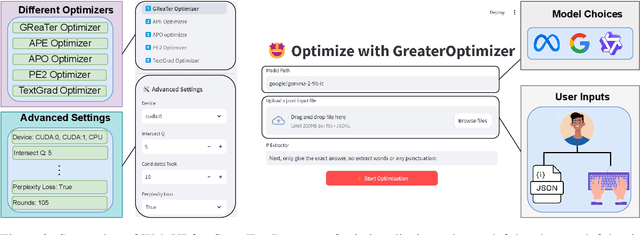

Abstract:LLMs have gained immense popularity among researchers and the general public for its impressive capabilities on a variety of tasks. Notably, the efficacy of LLMs remains significantly dependent on the quality and structure of the input prompts, making prompt design a critical factor for their performance. Recent advancements in automated prompt optimization have introduced diverse techniques that automatically enhance prompts to better align model outputs with user expectations. However, these methods often suffer from the lack of standardization and compatibility across different techniques, limited flexibility in customization, inconsistent performance across model scales, and they often exclusively rely on expensive proprietary LLM APIs. To fill in this gap, we introduce GREATERPROMPT, a novel framework that democratizes prompt optimization by unifying diverse methods under a unified, customizable API while delivering highly effective prompts for different tasks. Our framework flexibly accommodates various model scales by leveraging both text feedback-based optimization for larger LLMs and internal gradient-based optimization for smaller models to achieve powerful and precise prompt improvements. Moreover, we provide a user-friendly Web UI that ensures accessibility for non-expert users, enabling broader adoption and enhanced performance across various user groups and application scenarios. GREATERPROMPT is available at https://github.com/psunlpgroup/GreaterPrompt via GitHub, PyPI, and web user interfaces.
When Reasoning Meets Compression: Benchmarking Compressed Large Reasoning Models on Complex Reasoning Tasks
Apr 02, 2025Abstract:Recent open-source large reasoning models (LRMs) exhibit strong performance on complex reasoning tasks, but their large parameter count makes them prohibitively expensive for individuals. The compression of large language models (LLMs) offers an effective solution to reduce cost of computational resources. However, systematic studies on the performance of compressed LLMs in complex reasoning tasks, especially for LRMs, are lacking. Most works on quantization and pruning focus on preserving language modeling performance, while existing distillation works do not comprehensively benchmark student models based on reasoning difficulty or compression impact on knowledge and reasoning. In this paper, we benchmark compressed DeepSeek-R1 models on four different reasoning datasets (AIME 2024, FOLIO, Temporal Sequences of BIG-Bench Hard, and MuSiQue), ranging from mathematical to multihop reasoning, using quantization, distillation, and pruning methods. We benchmark 2.51-, 1.73-, and 1.58-bit R1 models that adopt dynamic quantization. We also benchmark distilled R1 models that are based on LLaMA or Qwen and run SparseGPT on them to obtain various sparsity levels. Studying the performance and behavior of compressed LRMs, we report their performance scores and test-time compute (number of tokens spent on each question). Notably, using MuSiQue, we find that parameter count has a much greater impact on LRMs' knowledge memorization than on their reasoning capability, which can inform the choice of compression techniques. Through our empirical analysis of test-time compute, we find that shorter model outputs generally achieve better performance than longer ones across several benchmarks for both R1 and its compressed variants, highlighting the need for more concise reasoning chains.
GReaTer: Gradients over Reasoning Makes Smaller Language Models Strong Prompt Optimizers
Dec 12, 2024


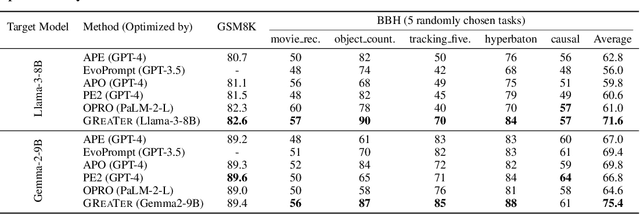
Abstract:The effectiveness of large language models (LLMs) is closely tied to the design of prompts, making prompt optimization essential for enhancing their performance across a wide range of tasks. Many existing approaches to automating prompt engineering rely exclusively on textual feedback, refining prompts based solely on inference errors identified by large, computationally expensive LLMs. Unfortunately, smaller models struggle to generate high-quality feedback, resulting in complete dependence on large LLM judgment. Moreover, these methods fail to leverage more direct and finer-grained information, such as gradients, due to operating purely in text space. To this end, we introduce GReaTer, a novel prompt optimization technique that directly incorporates gradient information over task-specific reasoning. By utilizing task loss gradients, GReaTer enables self-optimization of prompts for open-source, lightweight language models without the need for costly closed-source LLMs. This allows high-performance prompt optimization without dependence on massive LLMs, closing the gap between smaller models and the sophisticated reasoning often needed for prompt refinement. Extensive evaluations across diverse reasoning tasks including BBH, GSM8k, and FOLIO demonstrate that GReaTer consistently outperforms previous state-of-the-art prompt optimization methods, even those reliant on powerful LLMs. Additionally, GReaTer-optimized prompts frequently exhibit better transferability and, in some cases, boost task performance to levels comparable to or surpassing those achieved by larger language models, highlighting the effectiveness of prompt optimization guided by gradients over reasoning. Code of GReaTer is available at https://github.com/psunlpgroup/GreaTer.
Coverage-based Fairness in Multi-document Summarization
Dec 11, 2024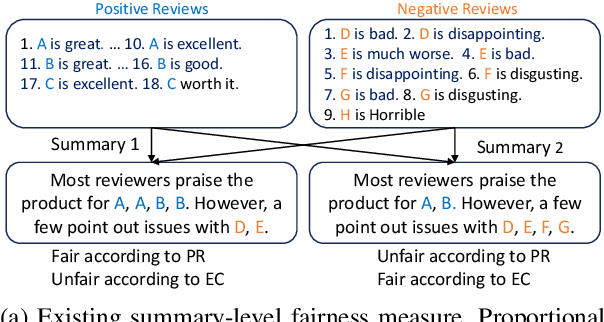

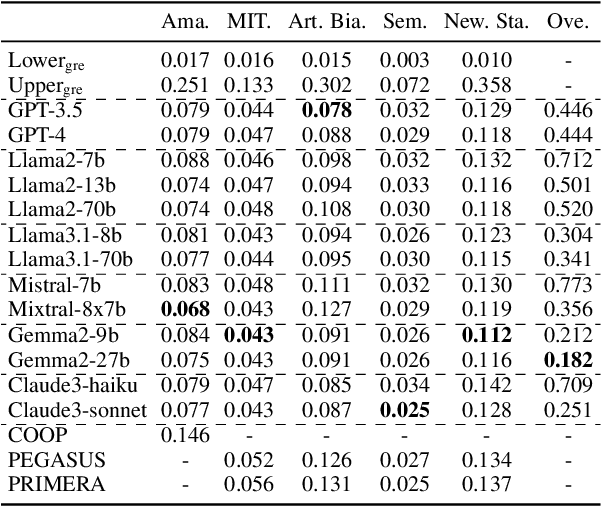
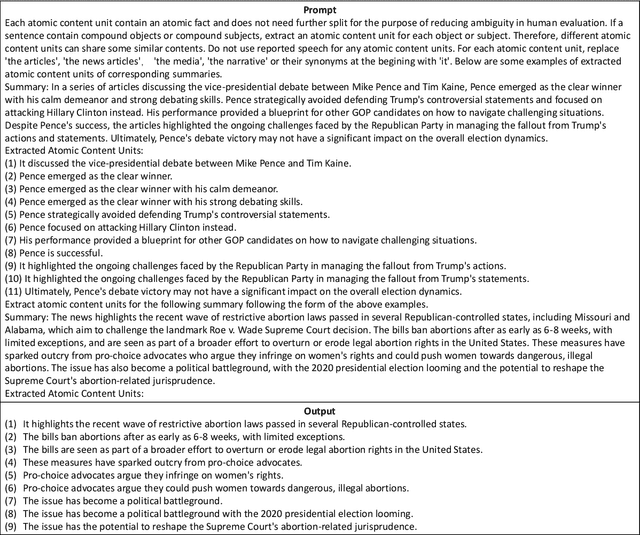
Abstract:Fairness in multi-document summarization (MDS) measures whether a system can generate a summary fairly representing information from documents with different social attribute values. Fairness in MDS is crucial since a fair summary can offer readers a comprehensive view. Previous works focus on quantifying summary-level fairness using Proportional Representation, a fairness measure based on Statistical Parity. However, Proportional Representation does not consider redundancy in input documents and overlooks corpus-level unfairness. In this work, we propose a new summary-level fairness measure, Equal Coverage, which is based on coverage of documents with different social attribute values and considers the redundancy within documents. To detect the corpus-level unfairness, we propose a new corpus-level measure, Coverage Parity. Our human evaluations show that our measures align more with our definition of fairness. Using our measures, we evaluate the fairness of thirteen different LLMs. We find that Claude3-sonnet is the fairest among all evaluated LLMs. We also find that almost all LLMs overrepresent different social attribute values.
VisOnlyQA: Large Vision Language Models Still Struggle with Visual Perception of Geometric Information
Dec 01, 2024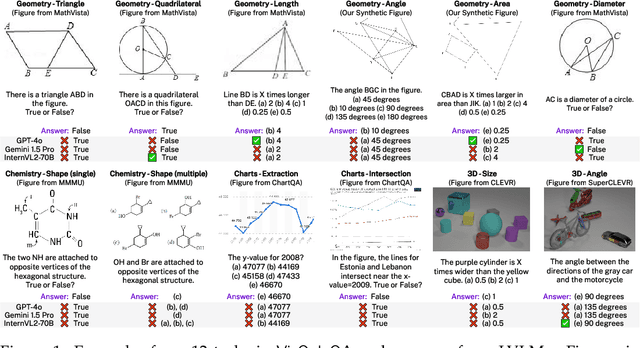

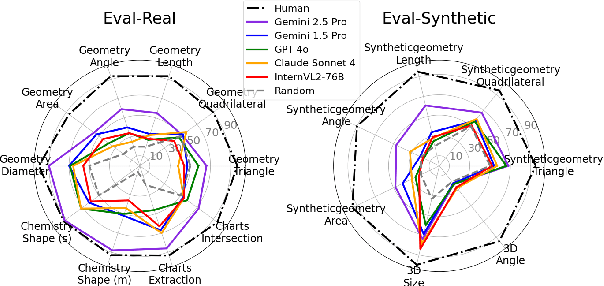

Abstract:Errors in understanding visual information in images (i.e., visual perception errors) remain a major source of mistakes in Large Vision Language Models (LVLMs). While further analysis is essential, there is a deficiency in datasets for evaluating the visual perception of LVLMs. In this work, we introduce VisOnlyQA, a new dataset designed to directly evaluate the visual perception capabilities of LVLMs on questions about geometric and numerical information in scientific figures. Our dataset enables us to analyze the visual perception of LVLMs for fine-grained visual information, independent of other capabilities such as reasoning. The evaluation set of VisOnlyQA includes 1,200 multiple-choice questions in 12 tasks on four categories of figures. We also provide synthetic training data consisting of 70k instances. Our experiments on VisOnlyQA highlight the following findings: (i) 20 LVLMs we evaluate, including GPT-4o and Gemini 1.5 Pro, work poorly on the visual perception tasks in VisOnlyQA, while human performance is nearly perfect. (ii) Fine-tuning on synthetic training data demonstrates the potential for enhancing the visual perception of LVLMs, but observed improvements are limited to certain tasks and specific models. (iii) Stronger language models improve the visual perception of LVLMs. In summary, our experiments suggest that both training data and model architectures should be improved to enhance the visual perception capabilities of LVLMs. The datasets, code, and model responses are provided at https://github.com/psunlpgroup/VisOnlyQA.
 Add to Chrome
Add to Chrome Add to Firefox
Add to Firefox Add to Edge
Add to Edge